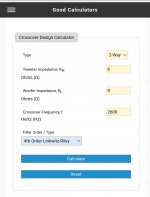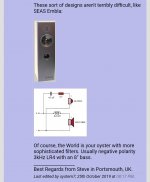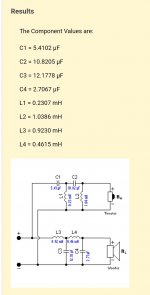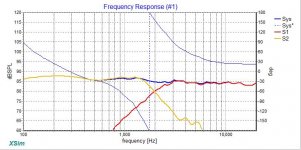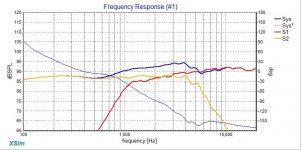Hi all,
Very glad to join the group have been an avid sound junkie since i got some SEAS Lotus speakers for my car about 15 years back.
I have recently acquired some Sansui gear from what i believe to be the 80s (Amplifier is 2x145 watt). If you want more info on the gear happy to share, but i am keen to build a pair of speaker to go with it.
Naturally i am choosing SEAS drivers, and the plan is to use:
Tweeter Seas Prestige H1499-06 27TBCD/GB-DXT (Tweeter Seas Prestige H1499-06 27TBCD/GB-DXT - Fidelity Components Shop)
Woofer Seas Prestige H1659-08 U22REX/P-SL (Woofer Seas Prestige H1659-08 U22REX/P-SL - Fidelity Components Shop)
I believe someone highly revered in this forum has used these components together, so glad to have made this marriage.
Being an abosulte noob on the speaker build side (i have fitted speaker system into my car, but had the pre-fab Crossover), dont really know where to start on the crossover. I noticed that in Gerhard's Arkadia build he used a 2600hz crossover frequency which i guess is a great place to start, but if anyone has any resources to help with with polarty and where to start on an actual cross build i would be ever so grateful.
Further to that, being in north america, does nayone have a best supplier to but these drivers from. I have so far seen Audiohobby.eu as a great supplier but open to other options based out of North America.
Thanks for your time, i look forward to sharing!
Bram from Claagry Alberta
Very glad to join the group have been an avid sound junkie since i got some SEAS Lotus speakers for my car about 15 years back.
I have recently acquired some Sansui gear from what i believe to be the 80s (Amplifier is 2x145 watt). If you want more info on the gear happy to share, but i am keen to build a pair of speaker to go with it.
Naturally i am choosing SEAS drivers, and the plan is to use:
Tweeter Seas Prestige H1499-06 27TBCD/GB-DXT (Tweeter Seas Prestige H1499-06 27TBCD/GB-DXT - Fidelity Components Shop)
Woofer Seas Prestige H1659-08 U22REX/P-SL (Woofer Seas Prestige H1659-08 U22REX/P-SL - Fidelity Components Shop)
I believe someone highly revered in this forum has used these components together, so glad to have made this marriage.
Being an abosulte noob on the speaker build side (i have fitted speaker system into my car, but had the pre-fab Crossover), dont really know where to start on the crossover. I noticed that in Gerhard's Arkadia build he used a 2600hz crossover frequency which i guess is a great place to start, but if anyone has any resources to help with with polarty and where to start on an actual cross build i would be ever so grateful.
Further to that, being in north america, does nayone have a best supplier to but these drivers from. I have so far seen Audiohobby.eu as a great supplier but open to other options based out of North America.
Thanks for your time, i look forward to sharing!
Bram from Claagry Alberta
You might consider following an existing design, e.g. www.audioexcite.com >> Prestigious Two – Monitor DXT - this uses the DXT with the U16 instead of the U22.
There are many threads on 1 + 8" two-ways you may want to review; the general concept is to find a tweeter that can cross notably lower than usual to avoid beaming at the end of an 8" driver's comfort zone
Seas U22REX/P-SL any good in a ported 2way
Seas A26 Devore Style Build
Woofer suggestion for Harbeth like 2 way
Seas Idunn Crossover.
There are many threads on 1 + 8" two-ways you may want to review; the general concept is to find a tweeter that can cross notably lower than usual to avoid beaming at the end of an 8" driver's comfort zone
Seas U22REX/P-SL any good in a ported 2way
Seas A26 Devore Style Build
Woofer suggestion for Harbeth like 2 way
Seas Idunn Crossover.
Last edited:
Thank you Motokok for your response.
In reviewing this, it seems that Steve mentioend in a post a 3kHz LR4 crossover with reverse polarity.
I have attached a crossover calculator that i found to determine the number based on such a crossover. While i have never made a crossover i am sure there are enough resources to determine how to build it based on the picture shown.
Firstly, is this a good calculator or are there other out there better?
Secondly, how do i add the reverse polarity that was mentioend within the crossover? The calculator attached only specifies normal polarity.
In reviewing this, it seems that Steve mentioend in a post a 3kHz LR4 crossover with reverse polarity.
I have attached a crossover calculator that i found to determine the number based on such a crossover. While i have never made a crossover i am sure there are enough resources to determine how to build it based on the picture shown.
Firstly, is this a good calculator or are there other out there better?
Secondly, how do i add the reverse polarity that was mentioend within the crossover? The calculator attached only specifies normal polarity.
Attachments
Better read Introduction to designing crossovers without measurement
Textbook calculators are not very good for passive crossovers because driver impedance is not linear and so filter response and therefore woofer-tweeter summation will not behave as intended. Another reason to follow a published design when starting from scratch and without measuring equipment. Also eliminates the work of designing the cabinet and port tuning. The poster in that other thread was using a digital crossover so a lot more flexibility when adjusting the crossover. Not to discourage your plans; things to think about.
Inverting polarity would mean wiring the positive amp signal to the negative driver input.
Textbook calculators are not very good for passive crossovers because driver impedance is not linear and so filter response and therefore woofer-tweeter summation will not behave as intended. Another reason to follow a published design when starting from scratch and without measuring equipment. Also eliminates the work of designing the cabinet and port tuning. The poster in that other thread was using a digital crossover so a lot more flexibility when adjusting the crossover. Not to discourage your plans; things to think about.
Inverting polarity would mean wiring the positive amp signal to the negative driver input.
Last edited:
Also read here: So you want to design your own speaker from scratch!
One thing I've been meaning to ask is, what's the purpose of crossover calculators? Yes, I know they don't work, but why do they even exist?
EDIT: Even with all the measuring gear, software and books etc, It took me about two years to produce something that wasn't terrible. Get yourself a copy of the Loudspeaker Design Cookbook.
One thing I've been meaning to ask is, what's the purpose of crossover calculators? Yes, I know they don't work, but why do they even exist?
EDIT: Even with all the measuring gear, software and books etc, It took me about two years to produce something that wasn't terrible. Get yourself a copy of the Loudspeaker Design Cookbook.
Last edited:
This was and still is a remarkably well thought out design. Easy to build yet very good design goals. And Mark K reached them I would say. Yet there are a few other DXT designs, check out the Heissmann monitor.Also Mark K's ER18DXT ; uses the DXT with the ER18RNX
In general I believe the DXT matches better to a 5" to 7" driver, depending on crossover frequency, topology and (less) cabinet shape. If good directivity is of your concern, an 8" deserves a bigger waveguide in order to cross low enough.
Thanks for all the input. I appreciate people taking a noobie in!
After reading Introduction to designing crossovers without measurement Im starting to get a better sense of things, and that, for my first try, I may go for a pre fab, like the Idunn.
Does anyone have any thoughts on Madison and their crossover designs? Was looking at this : Seas Idunn 2-Way Speaker Kit - Pair - Parts Only
If Madison have good rep, wondering if i could use their other designs. They have some as follows:
W22EX-001 + D2905-9900 2way Passive Crossover Design - Madisound Speaker PDF Library
W22NY-001 + H1499 2way Passive Crossover Design - Madisound Speaker PDF Library
Further to this - how hard would it be to change drivers or adapt the above crossovers according to different drivers? I want to use Woofer Seas Prestige H1659-08 U22REX/P-SL (Woofer Seas Prestige H1659-08 U22REX/P-SL - Fidelity Components Shop) because it will be more forgiving than the w22ex i believe.
Based on previous comments on tweeter, this may be a better option to pair with the u22rex:
Seas Excel T35C-002 35mm Mid-Tweeter
Thanks for joing me on the journey!
After reading Introduction to designing crossovers without measurement Im starting to get a better sense of things, and that, for my first try, I may go for a pre fab, like the Idunn.
Does anyone have any thoughts on Madison and their crossover designs? Was looking at this : Seas Idunn 2-Way Speaker Kit - Pair - Parts Only
If Madison have good rep, wondering if i could use their other designs. They have some as follows:
W22EX-001 + D2905-9900 2way Passive Crossover Design - Madisound Speaker PDF Library
W22NY-001 + H1499 2way Passive Crossover Design - Madisound Speaker PDF Library
Further to this - how hard would it be to change drivers or adapt the above crossovers according to different drivers? I want to use Woofer Seas Prestige H1659-08 U22REX/P-SL (Woofer Seas Prestige H1659-08 U22REX/P-SL - Fidelity Components Shop) because it will be more forgiving than the w22ex i believe.
Based on previous comments on tweeter, this may be a better option to pair with the u22rex:
Seas Excel T35C-002 35mm Mid-Tweeter
Thanks for joing me on the journey!
The Idunn has been subject to quite a few threads from owners asking for help to improve the sound; a lot of the DIY Seas kits' crossovers were designed based on simulation / datasheet measurements, ditto the Madisound PDFs. I wouldn't go for those.
What's preferred is that the design is measured and tweaked with drivers in a real cabinet, on a real baffle, e.g. the Audioexcite and Mark K designs.
You could certainly take from all of them and create something rational blending elements of each design.
The T35 is a nice tweeter and is the mainstay of the A26, but it's very pricey and if you're not going with the U22, then better value is to be had with 3/4" or 1" tweeters.
What's preferred is that the design is measured and tweaked with drivers in a real cabinet, on a real baffle, e.g. the Audioexcite and Mark K designs.
You could certainly take from all of them and create something rational blending elements of each design.
The T35 is a nice tweeter and is the mainstay of the A26, but it's very pricey and if you're not going with the U22, then better value is to be had with 3/4" or 1" tweeters.
Last edited:
you should not get hung up on any particular brand for drivers but look for a speaker which can provide a good platform for tweaking and learning with help available on the forum. Something like:
10F/8424 & RS225-8 FAST / WAW Ref Monitor
crossing from an 8inch driver to a 3-1/2 inch capable of playing up to 15kHz is a much better config for off-axis dispersion then going to a conventional 1inch tweeter.
also check out kits from zaph, troels gravesen, jeff bagby, paul carmody, at al. before starting from scratch. measurement equipment is needed to do a good job as well as sim software available here: Vcad, Xsim, PCD, etc. Lots of ways to have fun and waste money in the process 😉. Having an active Xover where one can listen to filter changes made on the fly is really beneficial to a diyselfer.
10F/8424 & RS225-8 FAST / WAW Ref Monitor
crossing from an 8inch driver to a 3-1/2 inch capable of playing up to 15kHz is a much better config for off-axis dispersion then going to a conventional 1inch tweeter.
also check out kits from zaph, troels gravesen, jeff bagby, paul carmody, at al. before starting from scratch. measurement equipment is needed to do a good job as well as sim software available here: Vcad, Xsim, PCD, etc. Lots of ways to have fun and waste money in the process 😉. Having an active Xover where one can listen to filter changes made on the fly is really beneficial to a diyselfer.
Last edited:
I agree with waxx. Lots of good options for you at Meniscus Audio. Call them, they are in Michigan, and talk to either Mark or Chad about your goals and budget. They will give you a range of good options.
You can also call Madisound, they are in Wisconsin, and talk to either Brian or Adam. Again you'll get a range of options and mostly different from the ones you'll get from Meniscus.
Try them both. Be prepared to discuss you music tastes, room size, loudness expectations, budget, etc.
Most important though definitely order a kit by one the well known designers. Don't try to do it yourself using some crossover software. It's not that simple to get it right despite what some people on these forums would like you to believe.
fatmarley in Post #6 talks about how it took him two years to get it right. Probably a pretty typical experience.
You can also call Madisound, they are in Wisconsin, and talk to either Brian or Adam. Again you'll get a range of options and mostly different from the ones you'll get from Meniscus.
Try them both. Be prepared to discuss you music tastes, room size, loudness expectations, budget, etc.
Most important though definitely order a kit by one the well known designers. Don't try to do it yourself using some crossover software. It's not that simple to get it right despite what some people on these forums would like you to believe.
fatmarley in Post #6 talks about how it took him two years to get it right. Probably a pretty typical experience.
Last edited:
Definitely the best thing to ensure you're happy is to purchase a kit, or build an established design which provides the cabinet design, BoM and crossover schematic. I'd also suggest choosing a project which has been built by many people and has a good number reviews which, among other things, may give you an idea of their sound.
Don't get too hung up on the brand or cost of drivers, as excellent results can be obtained with less expensive parts if the crossover and cabinet design are done right.
I've made four pairs of speakers, two test builds and the only one I wasn't happy with was the one where I tried to design the crossover.
Good luck with your project
Geoff
Don't get too hung up on the brand or cost of drivers, as excellent results can be obtained with less expensive parts if the crossover and cabinet design are done right.
I've made four pairs of speakers, two test builds and the only one I wasn't happy with was the one where I tried to design the crossover.
Good luck with your project
Geoff
Crossover Calculators
Hopefully the advice above has encouraged you to build an existing project. To illustrate why crossover calculators are not a good idea, here's a comparison of a properly designed crossover (not mine) with one which uses calculated values.
The one on the left (no.1) is the correct sim, you can see the calculated one (No. 2) would sound awful.
Firstly, is this a good calculator or are there other out there better?
Hopefully the advice above has encouraged you to build an existing project. To illustrate why crossover calculators are not a good idea, here's a comparison of a properly designed crossover (not mine) with one which uses calculated values.
The one on the left (no.1) is the correct sim, you can see the calculated one (No. 2) would sound awful.
Attachments
My friend, you show TALENT here:
https://www.diyaudio.com/forums/multi-way/147632-classic-monitor-designs-45.html#post5143726
Excellent choice of drivers for a two-way. The rest is just technique. You are following in the footsteps of speaker genius Joachim Gerhard.
https://www.diyaudio.com/forums/multi-way/147632-classic-monitor-designs-45.html#post5143726
Excellent choice of drivers for a two-way. The rest is just technique. You are following in the footsteps of speaker genius Joachim Gerhard.
Vituix CAD
Is a very fun free download.
Like anything has a learning curve and numerous tutorials online/Youtube
You can calculative enclosure alignments.
(Box Size, Vent Lengths, Port Velocity Etc Etc)
Also would provide a much more accurate starting place for crossover design.
With a crossover design section as well.
You need frequency response files ( .Frd)
And impedance curve file ( .Zma)
" Online Calculators " assume a static impedance curve such as 4 ohms or 8 ohms
A actual speaker has a impedance curve that can swing from 4 to 40 ohms depending
on frequency.
So the crossover more has to be designed knowing the actual impedance curve.
And the response in the enclosure you build.
If you have accurate vertical / and horizontal .Frd files
you will be able to see in Virtuix if speaker phase and higher order filter phase
causes dips off and on axis.
Is a very fun free download.
Like anything has a learning curve and numerous tutorials online/Youtube
You can calculative enclosure alignments.
(Box Size, Vent Lengths, Port Velocity Etc Etc)
Also would provide a much more accurate starting place for crossover design.
With a crossover design section as well.
You need frequency response files ( .Frd)
And impedance curve file ( .Zma)
" Online Calculators " assume a static impedance curve such as 4 ohms or 8 ohms
A actual speaker has a impedance curve that can swing from 4 to 40 ohms depending
on frequency.
So the crossover more has to be designed knowing the actual impedance curve.
And the response in the enclosure you build.
If you have accurate vertical / and horizontal .Frd files
you will be able to see in Virtuix if speaker phase and higher order filter phase
causes dips off and on axis.
.ZMA and .FRD in a zip
for both drivers
.FRD is just on axis as measured from manufacture according to data sheet.
.ZMA impedance based on free air, infinite baffle
Vituix Cad Download link
VituixCAD Loudspeaker simulator
woofer is ok, tweeter is mounted on a mounting plate/waveguide or DXT Lens as quoted from manufacture
as with many tweeters on a guide/ mount plate it causes a huge rise early on and drops off hard @ 10K
very visible in the data sheet.
I personally dont find it to be a very great tweeter response wise
for both drivers
.FRD is just on axis as measured from manufacture according to data sheet.
.ZMA impedance based on free air, infinite baffle
Vituix Cad Download link
VituixCAD Loudspeaker simulator
woofer is ok, tweeter is mounted on a mounting plate/waveguide or DXT Lens as quoted from manufacture
as with many tweeters on a guide/ mount plate it causes a huge rise early on and drops off hard @ 10K
very visible in the data sheet.
I personally dont find it to be a very great tweeter response wise
Attachments
Last edited:
Definitely the best thing to ensure you're happy is to purchase a kit, or build an established design which provides the cabinet design, BoM and crossover schematic. I'd also suggest choosing a project which has been built by many people and has a good number reviews which, among other things, may give you an idea of their sound.
Don't get too hung up on the brand or cost of drivers, as excellent results can be obtained with less expensive parts if the crossover and cabinet design are done right.
I've made four pairs of speakers, two test builds and the only one I wasn't happy with was the one where I tried to design the crossover.
Good luck with your project
Geoff
Geoff,
I think this a very important post. There are plenty of people here who write about how to design your own crossover with software and make it sound like it’s a piece of cake.
But when you look at the many years of experience, trial and error builds, and accumulated knowledge that people like Jeff Bagby, Paul Carmody, Dennis Murphy, and others, needed to get to their level of competency it’s pretty clear that a novice has little chance of getting there by simply designing a crossover with some packaged software.
Your experience seems to validate that pretty well.
Geoff,
I think this a very important post. There are plenty of people here who write about how to design your own crossover with software and make it sound like it’s a piece of cake.
But when you look at the many years of experience, trial and error builds, and accumulated knowledge that people like Jeff Bagby, Paul Carmody, Dennis Murphy, and others, needed to get to their level of competency it’s pretty clear that a novice has little chance of getting there by simply designing a crossover with some packaged software.
Your experience seems to validate that pretty well.
Agree!
You wouldn't think it, but you only have to look at some measurements of established manufacturers to see that even they can get it wrong.
Not that I'd suggest anyone not give it a go. It's very satisfying when you get it right - or is that just the Dunning-Kruger effect? 🙂
As I said several times, choosing between to build a proven design or to design yourself depends entirely on a long term vision.
If someone wants to have a hobby, doesn't really care on the short term outcome, expects (lot of) failures on the road, is willing to spend money on equipment and on failed projects, then the idea of trying to design yourself is viable. But the idea that the first project will be successful is really foolish.
OTOH if the whole goal is to have a good sounding speaker on the first build, then the only option is to build a proven design.
Ralf
Crossover calculators assume drivers with constant impedance and flat frequency response. Such drivers don't exist, so the whole concept of a crossover calculator is flawed. Not counting also some other effects like baffle step and diffraction or the time delay between drivers.
If someone wants to have a hobby, doesn't really care on the short term outcome, expects (lot of) failures on the road, is willing to spend money on equipment and on failed projects, then the idea of trying to design yourself is viable. But the idea that the first project will be successful is really foolish.
OTOH if the whole goal is to have a good sounding speaker on the first build, then the only option is to build a proven design.
Ralf
Crossover calculators assume drivers with constant impedance and flat frequency response. Such drivers don't exist, so the whole concept of a crossover calculator is flawed. Not counting also some other effects like baffle step and diffraction or the time delay between drivers.
- Home
- Loudspeakers
- Multi-Way
- Help a Newcomer! Speaker Build
